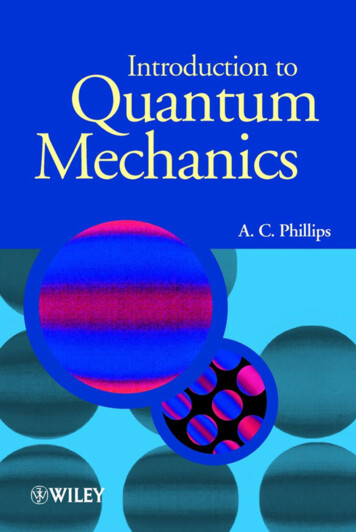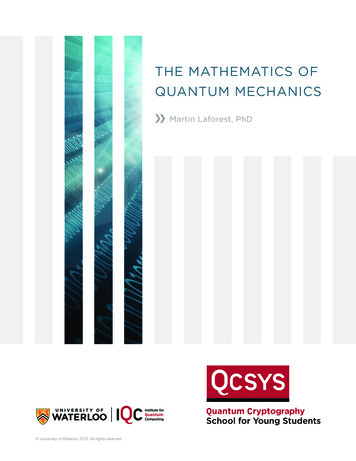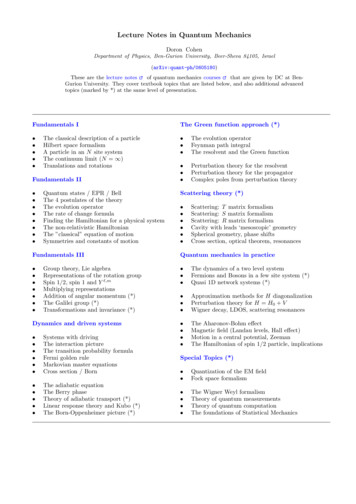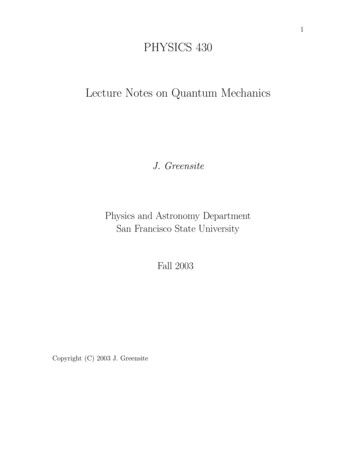
Transcription
Introduction to Quantum Mechanics
The Manchester Physics SeriesGeneral EditorsD. J. SANDIFORD: F. MANDL: A. C. PHILLIPSDepartment of Physics and Astronomy,University of ManchesterProperties of Matter:B. H. Flowers and E. MendozaStatistical Physics:Second EditionF. MandlElectromagnetism:Second EditionI. S. Grant and W. R. PhillipsStatistics:R. J. BarlowSolid State Physics:Second EditionJ. R. Hook and H. E. HallQuantum Mechanics:F. MandlParticle Physics:Second EditionB. R. Martin and G. ShawThe Physics of Stars:Second EditionA. C. PhillipsComputing for Scientists:R. J. Barlow and A. R. BarnettNuclear Physics:J. S. LilleyIntroduction to Quantum Mechanics: A. C. Phillips
INTRODUCTION TOQUANTUM MECHANICSA. C. PhillipsDepartment of Physics and AstronomyUniversity of Manchester
Copyright # 2003 by John Wiley & Sons Ltd,The Atrium, Southern Gate, Chichester,West Sussex, PO19 8SQ, EnglandNational 01243 779777International ( 44) 1243 779777e-mail (for orders and customer service enquiries): cs-books@wiley.co.ukVisit our Home Page on http://www.wiley.co.ukor http://www.wiley.comAll rights reserved. No part of this publication may be reproduced, storedin a retrieval system, or transmitted, in any form or by any means, electronic,mechanical, photocopying, recording, scanning or otherwise, except under the termsof the Copyright, Designs and Patents Act 1988 or under the terms of a licence issuedby the Copyright Licensing Agency, 90 Tottenham Court Road, London, UK W1P 9HE,without the permission in writing of the publisher.Other Wiley Editorial OfficesJohn Wiley & Sons, Inc., 605 Third Avenue,New York, NY 10158-0012, USAWiley-VCH Verlag GmbH, Pappelallee 3,D-69469 Weinheim, GermanyJohn Wiley & Sons (Australia) Ltd, 33 Park Road, Milton,Queensland 4064, AustraliaJohn Wiley & Sons (Asia) Pte Ltd, 2 Clementi Loop #02-01,Jin Xing Distripark, Singapore 0512John Wiley & Sons (Canada) Ltd, 22 Worcester Road,Rexdale, Ontario M9W 1L1, CanadaLibrary of Congress Cataloging-in-Publication DataBritish Library Cataloguing in Publication DataA catalogue record for this book is available from the British LibraryISBN 0-470-85323-9 (Hardback)0-470-85324-7 (Paperback)Typeset by Kolam Information Services Pvt. Ltd., Pondicherry, IndiaPrinted and bound in Great Britain by Antony Rowe Ltd, Chippenham, WiltshireThis book is printed on acid-free paper responsibly manufactured from sustainableforestry, in which at least two trees are planted for each one used for paper production.
To my sons:JosephMichaelPatrickPeter
This page intentionally left blank
ContentsForewordEditor's preface to the Manchester Physics SeriesAuthor's preface1xvPhotonsDe Broglie WavesAtomsMeasurementThe uncertainty principleMeasurement and wave particle dualityMeasurement and non-localityProblems 11471011131617È DINGER EQUATIONTHE SCHRO2.12.23xiiiPLANCK'S CONSTANT IN ACTION1.11.21.31.42xiWavesSinusoidal wavesLinear superpositions of sinusoidal wavesDispersive and non-dispersive wavesParticle Wave EquationsA wave equation for a free particleWave equation for a particle in a potential energy fieldProblems 22121222326272931POSITION AND MOMENTUM3.1 ProbabilityDiscrete random variablesContinuous random variables3.2 Position ProbabilitiesTwo-slit interferenceThe Born interpretation of the wave function353537383841
viiiContents3.33.43.53.644.54.6The Hamiltonian OperatorNormal Modes of a StringStates of Certain EnergyA Particle in a Box IIA one-dimensional boxA three-dimensional boxStates of Uncertain EnergyBasis functionsEnergy probability amplitudesTime DependenceProblems 45960636666697171737477SQUARE WELLS AND BARRIERS5.15.2642444648495052ENERGY AND TIME4.14.24.34.45Momentum ProbabilitiesA Particle in a Box IExpectation ValuesOperatorsUncertaintiesQuantum StatesProblems 3Bound and Unbound StatesBound statesUnbound statesGeneral implicationsBarrier PenetrationStationary state analysis of reflection and transmissionTunnelling through wide barriersTunnelling electronsTunnelling protonsProblems 58385889394959799100103THE HARMONIC OSCILLATOR6.16.26.36.46.56.6The Classical OscillatorThe Quantum OscillatorQuantum StatesStationary statesNon-stationary statesDiatomic MoleculesThree-dimensional OscillatorsThe Oscillator Eigenvalue ProblemThe ground state109110112112116118121123125
ContentsExcited statesIs E0 really the lowest energy?Mathematical properties of the oscillator eigenfunctionsPr o b l e m s 677.37.47.5Essential PropertiesPosition and MomentumEigenfunctions for positionEigenfunctions for momentumDelta function normalizationCompatible ObservablesCommutatorsA particle in one dimensionA particle in three dimensionsConstants of MotionProblems 7136138138139140141142143145146148ANGULAR MOMENTUM8.18.28.39126127128128OBSERVABLES AND OPERATORS7.17.28ixAngular Momentum BasicsMagnetic MomentsClassical magnetsQuantum magnetsMagnetic energies and the Stern Gerlach experimentOrbital Angular MomentumClassical orbital angular momentumQuantum orbital angular momentumAngular shape of wave functionsSpherical harmonicsLinear superpositionProblems 8155158158159161163163164164169171174THE HYDROGEN ATOM9.19.29.39.49.59.69.7Central PotentialsClassical mechanics of a particle in a central potentialQuantum mechanics of a particle in a central potentialQuantum Mechanics of the Hydrogen AtomEnergy levels and eigenfunctionsSizes and ShapesRadiative TransitionsThe Reduced Mass EffectRelativistic EffectsThe Coulomb Eigenvalue Problem179179182185188191194196198202
xContentsProblems 910IDENTICAL PARTICLES10.110.210.310.411205Exchange SymmetryPhysical ConsequencesExchange Symmetry with SpinBosons and FermionsP r o b l e m s 10213215219222224ATOMS11.111.211.3Atomic Quantum StatesThe central field approximationCorrections to the central field approximationThe Periodic TableWhat If ?P r o b l e m s 11229230234238241246Hints to selected problems249Further reading262Index263Physical constants and conversion factorsInside Back Cover
ForewordSadly, Tony Phillips, a good friend and colleague for more than thirty years,died on 27th November 2002. Over the years, we discussed most topics underthe sun. The originality and clarity of his thoughts and the ethical basis of hisjudgements always made this a refreshing exercise. When discussing physics,quantum mechanics was a recurring theme which gained prominence after hisdecision to write this book. He completed the manuscript three months beforehis death and asked me to take care of the proofreading and the Index. Alabour of love. I knew what Tony wantedÐand what he did not want. Exceptfor corrections, no changes have been made.Tony was an outstanding teacher who could talk with students of all abilities.He had a deep knowledge of physics and was able to explain subtle ideas in asimple and delightful style. Who else would refer to the end-point of nuclearfusion in the sun as sunshine? Students appreciated him for these qualities, hisstraightforwardness and his genuine concern for them. This book is a fittingmemorial to him.Franz MandlDecember 2002
This page intentionally left blank
Editors' preface to theManchester Physics SeriesThe Manchester Physics Series is a series of textbooks at first degree level. Itgrew out of our experience at the Department of Physics and Astronomy atManchester University, widely shared elsewhere, that many textbooks containmuch more material than can be accommodated in a typical undergraduatecourse; and that this material is only rarely so arranged as to allow thedefinition of a short self-contained course. In planning these books we havehad two objectives. One was to produce short books: so that lecturers shouldfind them attractive for undergraduate courses; so that students should not befrightened off by their encyclopaedic size or price. To achieve this, we have beenvery selective in the choice of topics, with the emphasis on the basic physicstogether with some instructive, stimulating and useful applications. Our secondobjective was to produce books which allow courses of different lengths anddifficulty to be selected with emphasis on different applications. To achievesuch flexibility we have encouraged authors to use flow diagrams showing thelogical connections between different chapters and to put some topics in starredsections. These cover more advanced and alternative material which is notrequired for the understanding of latter parts of each volume.Although these books were conceived as a series, each of them is selfcontained and can be used independently of the others. Several of them aresuitable for wider use in other sciences. Each Author's Preface gives detailsabout the level, prerequisites, etc., of that volume.The Manchester Physics Series has been very successful with total sales ofmore than a quarter of a million copies. We are extremely grateful to the manystudents and colleagues, at Manchester and elsewhere, for helpful criticismsand stimulating comments. Our particular thanks go to the authors for all thework they have done, for the many new ideas they have contributed, and fordiscussing patiently, and often accepting, the suggestions of the editors.
xivEditors' preface to the Manchester Physics SeriesFinally we would like to thank our publishers, John Wiley & Sons, Ltd,for their enthusiastic and continued commitment to the Manchester PhysicsSeries.D. J. SandifordF. MandlA. C. PhillipsFebruary 1997
Author's prefaceThere are many good advanced books on quantum mechanics but there is adistinct lack of books which attempt to give a serious introduction at a levelsuitable for undergraduates who have a tentative understanding of mathematics, probability and classical physics.This book introduces the most important aspects of quantum mechanics inthe simplest way possible, but challenging aspects which are essential for ameaningful understanding have not been evaded. It is an introduction toquantum mechanics which. motivates the fundamental postulates of quantum mechanics by consideringthe weird behaviour of quantum particles. reviews relevant concepts in classical physics before corresponding conceptsare developed in quantum mechanics. presents mathematical arguments in their simplest form. provides an understanding of the power and elegance of quantum mechanicsthat will make more advanced texts accessible.Chapter 1 provides a qualitative description of the remarkable propertiesof quantum particles, and these properties are used as the guidelines for atheory of quantum mechanics which is developed in Chapters 2, 3 and 4.Insight into this theory is gained by considering square wells and barriers inChapter 5 and the harmonic oscillator in Chapter 6. Many of the concepts usedin the first six chapters are clarified and developed in Chapter 7. Angularmomentum in quantum mechanics is introduced in Chapter 8, but becauseangular momentum is a demanding topic, this chapter focusses on the ideasthat are needed for an understanding of the hydrogen atom in Chapter 9,identical particles in Chapter 10 and many-electron atoms in Chapter 11.Chapter 10 explains why identical particles are described by entangled quantumstates and how this entanglement for electrons leads to the Pauli exclusionprinciple.Chapters 7 and 10 may be omitted without significant loss of continuity.They deal with concepts which are not needed elsewhere in the book.
xviAuthor's prefaceI would like to express my thanks to students and colleagues at the University of Manchester. Daniel Guise helpfully calculated the energy levels in ascreened Coulomb potential. Thomas York used his impressive computingskills to provide representations of the position probabilities for particles withdifferent orbital angular momentum. Sean Freeman read an early version of thefirst six chapters and provided suggestions and encouragement. Finally, Iwould like to thank Franz Mandl for reading an early version of the bookand for making forcefully intelligent suggestions for improvement.A. C. PhillipsAugust 2002
1Planck's constant in actionClassical physics is dominated by two fundamental concepts. The first is theconcept of a particle, a discrete entity with definite position and momentumwhich moves in accordance with Newton's laws of motion. The second is theconcept of an electromagnetic wave, an extended physical entity with a presence at every point in space that is provided by electric and magnetic fieldswhich change in accordance with Maxwell's laws of electromagnetism. Theclassical world picture is neat and tidy: the laws of particle motion account forthe material world around us and the laws of electromagnetic fields accountfor the light waves which illuminate this world.This classical picture began to crumble in 1900 when Max Planck published atheory of black-body radiation; i.e. a theory of thermal radiation in equilibriumwith a perfectly absorbing body. Planck provided an explanation of the observed properties of black-body radiation by assuming that atoms emit andabsorb discrete quanta of radiation with energy E hn, where n is the frequencyof the radiation and h is a fundamental constant of nature with valueh 6:626 10ÿ34 J s:This constant is now called Planck's constant.In this chapter we shall see that Planck's constant has a strange role oflinking wave-like and particle-like properties. In so doing it reveals that physicscannot be based on two distinct, unrelated concepts, the concept of a particleand the concept of a wave. These classical concepts, it seems, are at bestapproximate descriptions of reality.1.1PHOTONSPhotons are particle-like quanta of electromagnetic radiation. They travel atthe speed of light c with momentum p and energy E given by
2Planck's constant in actionp hlChap. 1andE hc,l(1:1)where l is the wavelength of the electromagnetic radiation. In comparison withmacroscopic standards, the momentum and energy of a photon are tiny. Forexample, the momentum and energy of a visible photon with wavelengthl 663 nm arep 10ÿ27 J sandE 3 10ÿ19 J:We note that an electronvolt, 1 eV 1:602 10ÿ19 J, is a useful unit for theenergy of a photon: visible photons have energies of the order of an eV andX-ray photons have energies of the order of 10 keV.The evidence for the existence of photons emerged during the early yearsof the twentieth century. In 1923 the evidence became compelling whenA. H. Compton showed that the wavelength of an X-ray increases when it isscattered by an atomic electron. This effect, which is now called the Comptoneffect, can be understood by assuming that the scattering process is a photon electron collision in which energy and momentum are conserved. As illustratedin Fig. 1.1, the incident photon transfers momentum to a stationary electron sothat the scattered photon has a lower momentum and hence a longer wavelength. In fact, when the photon is scattered through an angle y by a stationaryelectron of mass me , the increase in wavelength is given byDl h(1 ÿ cos y):me c(1:2)We note that the magnitude of this increase in wavelength is set bypfpiqPfFig. 1.1 A photon electron collision in which a photon is scattered by a stationaryelectron through an angle y. Because the electron recoils with momentum Pf , themagnitude of the photon momentum decreases from pi to pf and the photon wavelengthincreases.
1.13Photonsh 2:43 10ÿ12 m,me ca fundamental length called the Compton wavelength of the electron.The concept of a photon provides a natural explanation of the Comptoneffect and of other particle-like electromagnetic phenomena such as the photoelectric effect. However, it is not clear how the photon can account for thewave-like properties of electromagnetic radiation. We shall illustrate this difficulty by considering the two-slit interference experiment which was first used byThomas Young in 1801 to measure the wavelength of light.The essential elements of a two-slit interference are shown in Fig. 1.2. Whenelectromagnetic radiation passes through the two slits it forms a pattern ofinterference fringes on a screen. These fringes arise because wave-like disturbances from each slit interfere constructively or destructively when they arrive atthe screen. But a close examination of the interference pattern reveals that it isthe result of innumerable photons which arrive at different points on the screen,as illustrated in Fig. 1.3. In fact, when the intensity of the light is very low, theinterference pattern builds up slowly as photons arrive, one by one, at randompoints on the screen after seemingly passing through both slits in a wave-likeway. These photons are not behaving like classical particles with well-definedtrajectories. Instead, when presented with two possible trajectories, one foreach slit, they seem to pass along both trajectories, arrive at a random pointon the screen and build up an interference pattern.DWave-like entityincident on two slitsR2PXdR1Fig. 1.2 A schematic illustration of a two-slit interference experiment consisting of twoslits with separation d and an observation screen at distance D. Equally spaced brightand dark fringes are observed when wave-like disturbances from the two slits interfereconstructively and destructively on the screen. Constructive interference occurs at thepoint P, at a distance x from the centre of the screen, when the path difference R1 ÿ R2 isan integer number of wavelengths. This path difference is equal to xd D if d D.
4Planck's constant in actionChap. 1Pattern formed by 100 quantum particlesPattern formed by 1000 quantum particlesPattern formed by 10 000 quantum particlesFig. 1.3 A computer generated simulation of the build-up of a two-slit interferencepattern. Each dot records the detection of a quantum particle on a screen positionedbehind two slits. Patterns formed by 100, 1000 and 10 000 quantum particles areillustrated.At first sight the particle-like and wave-like properties of the photon arestrange. But they are not peculiar. We shall soon see that electrons, neutrons,atoms and molecules also behave in this strange way.1.2DE BROGLIE WAVESThe possibility that particles of matter like electrons could be both particle-likeand wave-like was first proposed by Louis de Broglie in 1923. Specifically heproposed that a particle of matter with momentum p could act as a wave withwavelengthhl :pThis wavelength is now called the de Broglie wavelength.(1:3)
1.2De Broglie Waves5It is often useful to write the de Broglie wavelength in terms of the energy ofthe particle. The general relation between the relativistic energy E and themomentum p of a particle of mass m isE2 ÿ p2 c2 m2 c4 :(1:4)This implies that the de Broglie wavelength of a particle with relativistic energyE is given byhcl p :(E ÿ mc2 )(E mc2 )(1:5)When the particle is ultra-relativistic we can neglect mass energy mc2 and obtainl hc,E(1:6)an expression which agrees with the relation between energy and wavelength fora photon given in Eq. (1.1). When the particle is non-relativistic, we can setE mc2 E,where E p2 2m is the kinetic energy of a non-relativistic particle, and obtainhl p :2mE(1:7)In practice, the de Broglie wavelength of a particle of matter is small anddifficult to measure. However, we see from Eq. (1.7) that particles of lowermass have longer wavelengths, which implies that the wave properties of thelightest particle of matter, the electron, should be the easiest to detect. Thewavelength of a non-relativistic electron is obtained by substitutingm me 9:109 10ÿ31 kg into Eq. (1.7). If we express the kinetic energy Ein electron volts, we obtainr 1:5nm:l E(1:8)From this equation we immediately see that an electron with energy of 1.5 eVhas a wavelength of 1 nm and that an electron with energy of 15 keV has awavelength of 0.01 nm.Because these wavelengths are comparable with the distances between atomsin crystalline solids, electrons with energies in the eV to keV range are diffracted
6Planck's constant in actionChap. 1by crystal lattices. Indeed, the first experiments to demonstrate the waveproperties of electrons were crystal diffraction experiments by C. J. Davissonand L. H. Germer and by G. P. Thomson in 1927. Davisson's experimentinvolved electrons with energy around 54 eV and wavelength 0.17 nm whichwere diffracted by the regular array of atoms on the surface of a crystal ofnickel. In Thomson's experiment, electrons with energy around 40 keV andwavelength 0.006 nm were passed through a polycrystalline target and diffracted by randomly orientated microcrystals. These experiments showedbeyond doubt that electrons can behave like waves with a wavelength givenby the de Broglie relation Eq. (1.3).Since 1927, many experiments have shown that protons, neutrons, atoms andmolecules also have wave-like properties. However, the conceptual implicationsof these properties are best explored by reconsidering the two-slit interferenceexperiment illustrated in Fig. 1.2. We recall that a photon passing through twoslits gives rise to wave-like disturbances which interfere constructively anddestructively when the photon is detected on a screen positioned behind theslits. Particles of matter behave in a similar way. A particle of matter, like aphoton, gives rise to wave-like disturbances which interfere constructively anddestructively when the particle is detected on a screen. As more and moreparticles pass through the slits, an interference pattern builds up on the observation screen. This remarkable behaviour is illustrated in Fig. 1.3.Interference patterns formed by a variety of particles passing through twoslits have been observed experimentally. For example, two-slit interference patterns formed by electrons have been observed by A. Tonomura, J. Endo,T. Matsuda, T. Kawasaki and H. Exawa (American Journal of Physics, vol. 57,p. 117 (1989)). They also demonstrated that a pattern still emerges even when thesource is so weak that only one electron is in transit at any one time, confirmingthat each electron seems to pass through both slits in a wave-like way beforedetection at a random point on the observation screen. Two-slit interferenceexperiments have been carried out using neutrons by R. GaÈhler and A. Zeilinger(American Journal of Physics, vol. 59, p. 316 (1991) ), and using atoms byO. Carnal and J. Mlynek (Physical Review Letters, vol. 66, p. 2689 (1991) ).Even molecules as complicated as C60 molecules have been observed to exhibitsimilar interference effects as seen by M. Arndt et al. (Nature, vol. 401, p. 680(1999) ).These experiments demonstrate that particles of matter, like photons, are notclassical particles with well-defined trajectories. Instead, when presented withtwo possible trajectories, one for each slit, they seem to pass along bothtrajectories in a wave-like way, arrive at a random point on the screen andbuild up an interference pattern. In all cases the pattern consists of fringeswith a spacing of lD d, where d is the slit separation, D is the screen distanceand l is the de Broglie wavelength given by Eq. (1.3).Physicists have continued to use the ambiguous word particle to describethese remarkable microscopic objects. We shall live with this ambiguity, but we
1.3 Atoms7shall occasionally use the term quantum particle to remind the reader that theobject under consideration has particle and wave-like properties. We have usedthis term in Fig. 1.3 because this figure provides a compelling illustration ofparticle and wave-like properties. Finally, we emphasize the role of Planck'sconstant in linking the particle and wave-like properties of a quantum particle.If Planck's constant were zero, all de Broglie wavelengths would be zero andparticles of matter would only exhibit classical, particle-like properties.1.3ATOMSIt is well known that atoms can exist in states with discrete or quantized energy.For example, the energy levels for the hydrogen atom, consisting of an electronand a proton, are shown in Fig. 1.4. Later in this book we shall show thatbound states of an electron and a proton have quantized energies given byContinuumof unboundenergy levelsE 0E3 13.6 eV32E2 13.6 eV22E1 13.6 eV12Fig. 1.4 A simplified energy level diagram for the hydrogen atom. To a good approximation the bound states have quantized energies given by En ÿ13:6 n2 eV where n, theprincipal quantum number, can equal 1, 2, 3, . . . . When the excitation energy is above13.6 eV, the atom is ionized and its energy can, in principle, take on any value in thecontinuum between E 0 and E 1.
8Planck's constant in actionChap. 1En ÿ13:6eV,n2(1:9)where n is a number, called the principal quantum number, which can take on aninfinite number of the values, n 1, 2, 3, . . . . The ground state of the hydrogenatom has n 1, a first excited state has n 2 and so on. When the excitationenergy is above 13.6 eV, the electron is no longer bound to the proton; the atomis ionized and its energy can, in principle, take on any value in the continuumbetween E 0 and E 1.The existence of quantized atomic energy levels is demonstrated by theobservation of electromagnetic spectra with sharp spectral lines that arisewhen an atom makes a transition between two quantized energy levels. Forexample, a transition between hydrogen-atom states with ni and nf leads to aspectral line with a wavelength l given byhc jEni ÿ Enf j:lSome of the spectral lines of atomic hydrogen are illustrated in Fig. 1.5.Quantized energy levels of atoms may also be revealed by scattering processes. For example, when an electron passes through mercury vapour it has ahigh probability of losing energy when its energy exceeds 4.2 eV, which is thequantized energy difference between the ground and first excited state of amercury atom. Moreover, when this happens the excited mercury atoms subsequently emit photons with energy E 4:2 eV and wavelengthl 200 nmhc 254 nm:E400 nm600 nmFig. 1.5 Spectral lines of atomic hydrogen. The series of lines in the visible part of theelectromagnetic spectrum, called the Balmer series, arises from transitions betweenstates with principal quantum number n 3, 4, 5, . . . and a state with n 2. The seriesof lines in the ultraviolet, called the Lyman series, arises from transitions between stateswith principal quantum number n 2, 3, . . . and the ground state with n 1.
1.3Atoms9But quantized energy levels are not the most amazing property of atoms.Atoms are surprisingly resilient: in most situations they are unaffected whenthey collide with neighbouring atoms, but if they are excited by such encountersthey quickly return to their original pristine condition. In addition, atoms of thesame chemical element are identical: somehow the atomic number Z, thenumber of electrons in the atom, fixes a specific identity which is common toall atoms with this number of electrons. Finally, there is a wide variation inchemical properties, but there is a surprisingly small variation in size; forexample, an atom of mercury with 80 electrons is only three times bigger thana hydrogen atom with one electron.These remarkable properties show that atoms are not mini solar systems inwhich particle-like electrons trace well-defined, classical orbits around a nucleus. Such an atom would be unstable because the orbiting electrons wouldradiate electromagnetic energy and fall into the nucleus. Even in the absence ofelectromagnetic radiation, the pattern of orbits in such an atom would changewhenever the atom collided with another atom. Thus, this classical picturecannot explain why atoms are stable, why atoms of the same chemical elementare always identical or why atoms have a surprisingly small variation insize.In fact, atoms can only be understood by focussing on the wave-like properties of atomic electrons. To some extent atoms behave like musical instruments.When a violin string vibrates with definite frequency, it forms a standing wavepattern of specific shape. When wave-like electrons, with definite energy, areconfined inside an atom, they form a wave pattern of specific shape. An atom isresilient because, when left alone, it assumes the shape of the electron wavepattern of lowest energy, and when the atom is in this state of lowest energythere is no tendency for the electrons to radiate energy and fall into the nucleus.However, atomic electrons can be excited and assume the shapes of wavepatterns of higher quantized energy.One of the most surprising characteristics of electron waves in an atom is thatthey are entangled so that it is not possible to tell which electron is which. As aresult, the possible electron wave patterns are limited to those that are compatible with a principle called the Pauli exclusion principle. These patterns, for anatom with an atomic number Z, uniquely determine the chemical properties ofall atoms with this atomic number.All these ideas will be considered in more detail in subsequent chapters, butat this stage we can show that the wave nature of atomic electrons provides anatural explanation for the typical size of atoms. Because the de Brogliewavelength of an electron depends upon the magnitude of Planck's constanth and the electron mass me , the size of an atom consisting of wave-like electronsalso depends upon h and me . We also expect a dependence on the strength ofthe force which binds an electron to a nucleus; this is proportional to e2 4pE0 ,where e is the magnitude of the charge on an electron and on a proton. Thus,the order of magnitude of the size of atoms is expected to be a function of
10Planck's constant in action Chap. 1e2 4pE0 , me and h (or h h 2p). In fact, the natural unit of length for atomicsize is the Bohr radius which is given by1 a0 24pE0 h 0:529 10ÿ10 m:e2 m e(1:10)Given this natural length, we can write down a natural unit for atomicbinding energies. This is called the Rydberg energy and it is given byER e2 13:6 eV:8pE0 a0(1:11)We note
There are many good advanced books on quantum mechanics but there is a distinct lack of books which attempt to give a serious introduction at a level suitable for undergraduates who have a tentative understanding of mathemat-ics, probability and classical physics. This book intr










